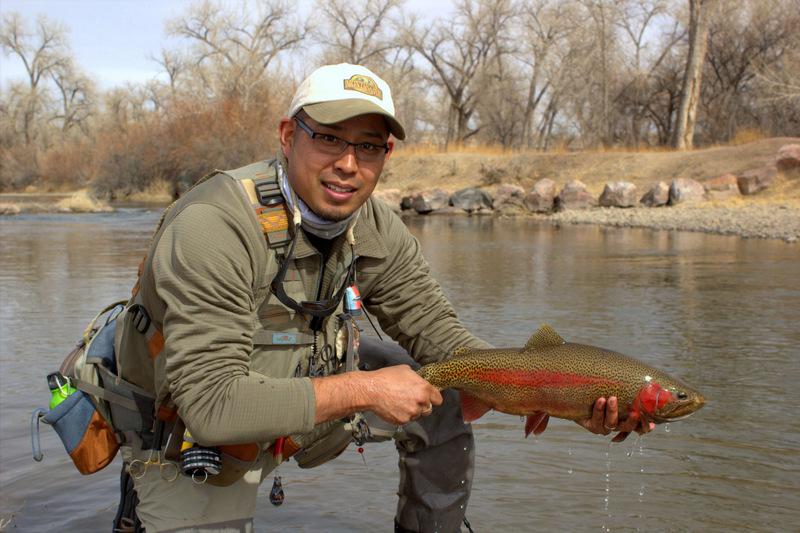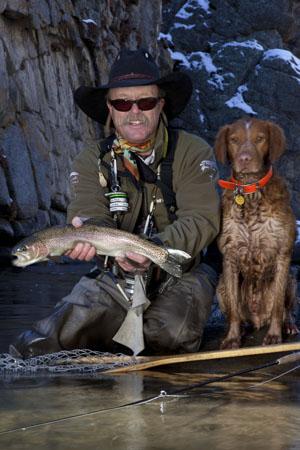Fishing High Water
Mid- to late-spring transitioning into summer presents an interesting time of year for fly fishing in Colorado. Prior to the spring runoff of winter’s snowpack, March and April offer some terrific days on the water. The waters are warming and so are fish, moving out of their winter-time sluggishness. Emergers and BWO hatches provide meals as they awaken from their winter doldrums. Then late April and May arrive and with them, higher flows and off-color water. What’s a fly fisher to do? Stay home? Do yard work? But wait — fly fishing just can’t come to a stop, right?
 I had the chance to talk with our Guides to answer that very question. Steve Gossage, one of our Guides, says “No, fishing does not stop in off color water. Sometimes it can be a blessing.”
I had the chance to talk with our Guides to answer that very question. Steve Gossage, one of our Guides, says “No, fishing does not stop in off color water. Sometimes it can be a blessing.”
High water fishing does offer challenges, to be sure. Let’s start with safety. Wading should probably be a distant second choice; fishing from the banks is your safest bet. Even then, watch where you’re stepping since wet grass, high foliage, and higher water levels can be deceiving. You might find yourself stepping into a hole in the bank. Or, due to the high and probably fluctuating water levels, the grass can be slicker.
If you do wade along the bank, know your water. The faster water makes footing unsteady, for sure.
 For the most part, you won’t be fishing too far out from the bank, anyway. “Think of being in a 100 mile an hour sandstorm,” Juan Ramirez tells his clients. “Where would you be? Out in the middle of it or hiding behind some cover?” Fish will seek safer cover and that means along the bank. Each river has it owns unique qualities and each is impacted differently by flows. One thing the rivers have in common, says Scott Tarrant, is that “fast water will move fish out of runs and onto edges.”
For the most part, you won’t be fishing too far out from the bank, anyway. “Think of being in a 100 mile an hour sandstorm,” Juan Ramirez tells his clients. “Where would you be? Out in the middle of it or hiding behind some cover?” Fish will seek safer cover and that means along the bank. Each river has it owns unique qualities and each is impacted differently by flows. One thing the rivers have in common, says Scott Tarrant, is that “fast water will move fish out of runs and onto edges.”
You have to pay attention to flows. Ramirez checks the flows in several locations along the river before he heads out. “Generally, the South Platte will stay pretty consistent throughout the entire system as flows are regulated. The upper Arkansas River is a freestone with no regulation, although there are supplemental flows added due to the Frying Pan – Arkansas project.” Since we have a heavy snowpack this winter, it will be important to watch how much water they are dumping out of reservoirs. “If I see a big jump, or even a big drop, the fish will have to adjust a bit before things pick up again. Once they do, if there was an increase, it will provide a varied buffet of things fish can feed on. Worms, eggs, craneflies, scuds and stoneflies can be flushed around with the higher flows.”
 Greg Blessing agrees. “Fish eat at this time of year, big time, lots of large food items: stoneflies, SJ Worms, craneflies larvae. Small fish, pushed to the edges of the flows, are on the menu, too.”
Greg Blessing agrees. “Fish eat at this time of year, big time, lots of large food items: stoneflies, SJ Worms, craneflies larvae. Small fish, pushed to the edges of the flows, are on the menu, too.”
For that reason, all of the Guides agreed that high flows and off-color water can be a great time for streamer fishing. “In higher, dirtier water, streamer fishing can be fantastic!”
While high water presents challenges not seen earlier in the spring or after the runoff, it’s no reason to stay home. Fly fishers just have to be more attentive to changes (and conditions can fluctuate quickly), be more deliberate in the types of patterns they use, and approach the water with more caution.
